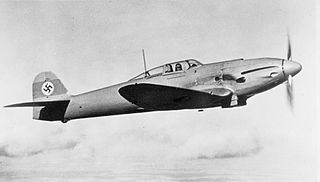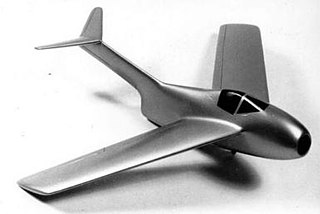
The Heinkel He 111 was a German bomber aircraft designed by Siegfried and Walter Günter at Heinkel Flugzeugwerke in 1934. Through development it was described as a "wolf in sheep's clothing". Due to restrictions placed on Germany after the First World War prohibiting bombers, it masqueraded as a civil airliner, although from conception the design was intended to provide the nascent Luftwaffe with a fast medium bomber.

The Heinkel He 219 Uhu ("Eagle-Owl") is a night fighter that served with the German Luftwaffe in the later stages of World War II. A relatively sophisticated design, the He 219 possessed a variety of innovations, including Lichtenstein SN-2 advanced VHF-band intercept radar, also used on the Ju 88G and Bf 110G night fighters. It was also the first operational military aircraft to be equipped with ejection seats and the first operational German World War II-era aircraft with tricycle landing gear. Had the Uhu been available in quantity, it might have had a significant effect on the strategic night bombing offensive of the Royal Air Force; however, only 294 of all models were built by the end of the war and these saw only limited service. Ernst-Wilhelm Modrow was the leading night fighter ace on the He 219. Modrow was credited with 33 of his 34 night air victories on the type.

The Heinkel He 112 is a German fighter aircraft designed by Walter and Siegfried Günter. It was one of four aircraft designed to compete for the 1933 fighter contract of the Luftwaffe, in which it came second behind the Messerschmitt Bf 109. Small numbers were used for a short time by the Luftwaffe and some were built for other countries, around 100 being completed.

The Arado Ar 234 Blitz was the world's first operational jet-powered bomber, built by the German Arado company in the closing stages of World War II.

Focke-Wulf Flugzeugbau AG was a German manufacturer of civil and military aircraft before and during World War II. Many of the company's successful fighter aircraft designs were slight modifications of the Focke-Wulf Fw 190. It is one of the predecessor companies of today's Airbus.

The Focke-Wulf Fw 187 Falke ("Falcon") was a German aircraft developed in the late 1930s. It was conceived by Kurt Tank as a twin-engine, high-performance fighter, but the Luftwaffe saw no role for the design, perceiving it as intermediate between the Messerschmitt Bf 109 and Bf 110. Later prototypes were adapted to two-seats to compete with the Bf 110 in the Zerstörer role, but only nine aircraft were built in total.
The Heinkel He 277 was a four-engine, long-range heavy bomber design, originating as a derivative of the He 177, intended for production and use by the German Luftwaffe during World War II. The main difference was in its engines. The He 177 used two Daimler-Benz DB 606 "power system" engines, each of which consisted of two combined Daimler-Benz DB 601 engines, each DB 606 weighed 1.5 tons. The He 177A-3 and its successors used two DB 610 "power system" engines, each of which consisted of two combined Daimler-Benz DB 605 engines, each DB 610 weighed 1.5 tons. Due to problems with both the DB 606 and the DB 610, the He 277 was intended to use four unitized BMW 801E 14-cylinder radial engines, each mounted in an individual nacelle and each turning a three-blade, four-meter diameter propeller.

The Messerschmitt Me 264 was a long-range strategic bomber developed during World War II for the German Luftwaffe as its main strategic bomber. The design was later selected as Messerschmitt's competitor in the Reichsluftfahrtministerium's Amerikabomber programme, for a strategic bomber capable of attacking New York City from bases in France or the Azores.

The Messerschmitt Me 328 was originally designed as a parasite aircraft to protect Luftwaffe bomber formations during World War II. During its protracted development, a wide variety of other roles were suggested for it. Late in the war, the design was resurrected for consideration as a Selbstopfer aircraft, but was judged unsuitable even for this purpose. The tiny fighter was to have been propelled by pulsejets, but the unsuitability of these engines doomed the Me 328 from the start.

Bomber B was a German military aircraft design competition organised just before the start of World War II to develop a second-generation high-speed bomber for the Luftwaffe. The new designs would be a direct successor to the Schnellbomber philosophy of the Dornier Do 17 and Junkers Ju 88, relying on high speed as its primary defence. Bomber B would also be a much larger and more capable aircraft, with range and payload far greater than the Schnellbombers, besting even the largest conventional designs then under consideration. The winning design was intended to form the backbone of the Luftwaffe bomber force, replacing the wide collection of semi-specialized designs then in service. The Reich Air Ministry was so optimistic that more modest projects were generally cancelled; when the project failed the Luftwaffe was left with hopelessly outdated aircraft.

The Jumo 211 was a German inverted V-12 aircraft engine, Junkers Motoren's primary aircraft engine of World War II. It was the direct competitor to the Daimler-Benz DB 601 and closely paralleled its development. While the Daimler-Benz engine was mostly used in single-engined and twin-engined fighters, the Jumo engine was primarily used in bombers such as Junkers' own Ju 87 and Ju 88, and Heinkel's H-series examples of the Heinkel He 111 medium bomber. It was the most-produced German aero engine of the war, with almost 70,000 examples completed.

The Focke-Wulf Fw 191 was a prototype German bomber of World War II, as the Focke-Wulf firm's entry for the Bomber B advanced medium bomber design competition. Two versions were intended to be produced, a twin-engine version using the Junkers Jumo 222 engine and a four-engine variant which was to have used the smaller Daimler-Benz DB 605 engine. The project was eventually abandoned due to technical difficulties with the engines.

A Schnellbomber is a bomber that relies upon speed to avoid enemy fighters, rather than having defensive armament and armor.

The Focke-Wulf Ta 183 Huckebein was a design for a jet-powered fighter aircraft intended as the successor to the Messerschmitt Me 262 and other day fighters in Luftwaffe service during World War II. It was developed only to the extent of wind tunnel models when the war ended, but the basic design was further developed postwar in Argentina as the FMA IAe 33 Pulqui II. The name Huckebein is a reference to a trouble-making raven from an illustrated story in 1867 by Wilhelm Busch.

The Emergency Fighter Program was the program that resulted from a decision taken on July 3, 1944 by the Luftwaffe regarding the German aircraft manufacturing companies during the last year of the Third Reich.
The Focke-Wulf Ta 400 was a large six-engined heavy bomber design developed in Nazi Germany in 1943 by Focke-Wulf as a serious contender for the Amerika Bomber project. One of the first aircraft to be developed from components from multiple countries, it was also one of the most advanced Focke-Wulf designs of World War II, though it never progressed beyond a wind tunnel model.
The Focke-Wulf Fw 238 was a four-engine low wing strategic bomber developed by the German aeronautical company Focke-Wulf-Flugzeugbau AG in the early 1940s and remained at the project stage. Designed to the same specifications issued by the Reichsluftfahrtministerium (RLM) which led to the Focke-Wulf Ta 400 and Junkers Ju 390, its development was cancelled by the RLM.















